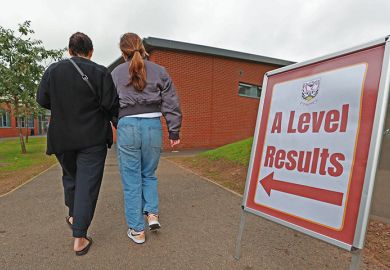Ucas has announced the three new questions that will replace the personal statement, as new figures show that the application gap for disadvantaged students is unchanged in a decade.
It has been hoped that the admissions service’s decision to scrap its central 4,000 character essay will help “level the playing field” and make the admissions process more fair.
Instead, students applying for 2026 entry will respond to three structured questions:
- Why do you want to study this course or subject?
- How have your qualifications and studies helped you to prepare for this course or subject?
- What else have you done to prepare outside of education, and why are these experiences helpful?
Jo Saxton, chief executive of Ucas, said the changes were part of a sector-wide effort to ensure more people from disadvantaged backgrounds can “benefit from the life-changing opportunity of higher education”.
“The new approach with guided questions aims to give greater confidence to those students, as well as their teachers when advising on how to secure their dream course,” she said.
However, she admitted that Ucas’ application figures for the 30 June deadline show that “whilst positive progress has been made, there is still much to do”.
The data shows that the application rate for UK 18-year-olds fell to 41.8 per cent for 2024 – down from 42.1 per cent last year, and the peak of 44.1 per cent in 2022.
Among the most disadvantaged students, it fell slightly to 27 per cent, while it remained unchanged for the least disadvantaged, at 57.6 per cent.
This meant that the application rate gap (of 30.6 percentage points) is unchanged from 2015.
Lee Elliot Major, professor of social mobility at the University of Exeter, said the personal statement has “increasingly become a barometer of middle-class privilege” because so many are edited and co-written by advisers, teachers and parents.
“This welcome reform strikes the right balance between a more structured approach to deter fabrication, while not limiting the opportunity for applicants to personalise their statement,” he added.
“I believe it is a significant step in making the university admissions system a little bit fairer for all applicants.”
The rest of the data also reveals some worrying signs for the sector more broadly. Ucas figures for the 31 January deadline revealed that applicants to UK courses were down slightly on the previous year.
But the final figures show a much larger fall, with a total of 667,650 students applying to UK courses – down 1.6 per cent on the year before.
Previous data also showed that the total number of international applicants rose almost 1 per cent. However, by the June deadline, it has fallen 1.9 per cent compared with the same date in 2023 – the largest fall on record, outside the pandemic.
The figures include undergraduates only so would not cover the vast majority of international applicants, who are postgraduate students.
But the Ucas data does show declines in some of the UK sector’s 10 largest recruitment markets. Indian applicant numbers decreased by 1.3 per cent compared to last year, which is the first fall since records began in 2007.
Other countries that saw declines include Hong Kong (10.7 per cent), Ireland (1.9 per cent) and Malaysia (2.2 per cent).
Register to continue
Why register?
- Registration is free and only takes a moment
- Once registered, you can read 3 articles a month
- Sign up for our newsletter
Subscribe
Or subscribe for unlimited access to:
- Unlimited access to news, views, insights & reviews
- Digital editions
- Digital access to THE’s university and college rankings analysis
Already registered or a current subscriber?







